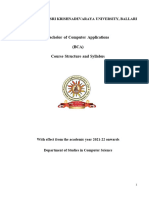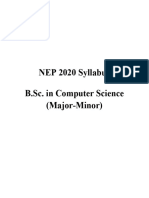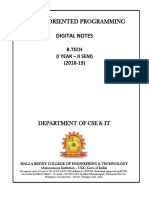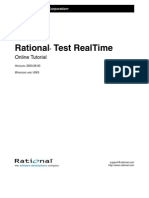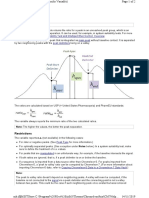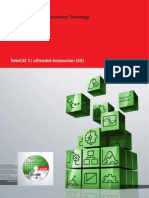I BCA I SEM - Programming With C - Syllabus
Uploaded by
talha292006I BCA I SEM - Programming With C - Syllabus
Uploaded by
talha292006I BCA I SEM
Programming with C
Unit - 1 (15 Hrs)
Introduction to C Programming: Overview of C; History and Features of C; Structure
of a C Program with Examples; Creating and Executing a C Program; Compilation
process in C.
C Programming Basic Concepts: C Character Set; C tokens - keywords, identifiers,
constants, and variables; Data types; Declaration & initialization of variables; Symbolic
constants.
Input and output with C: Formatted I/O functions - printf and scanf, control stings and
escape sequences, output specifications with printf functions; Unformatted I/O
functions to read and display single character and a string - getchar, putchar, gets and
puts functions.
C Operators & Expressions: Arithmetic operators; Relational operators; Logical
operators; Assignment operators; Increment & Decrement operators; Bitwise operators;
Conditional operator; Special operators; Operator Precedence and Associatively;
Evaluation of arithmetic expressions; Type conversion.
Unit – 2 (15 Hrs)
Control Structures: Decision making Statements - Simple if, if_else, nested if_else,
else_if ladder, Switch Case, goto, break & continue statements;
Looping Statements - Entry controlled and exit controlled statements, while, do-while,
for loops, Nested loops.
Derived data types in C: Arrays: One Dimensional arrays - Declaration, Initialization
and Memory representation; Two Dimensional arrays - Declaration, Initialization and
Memory representation.
Unit – 3 (15 Hrs)
Strings: Declaring & Initializing string variables; String handling functions - strlen,
strcmp, strcpy and strcat; Character handling functions - toascii, toupper, tolower,
isalpha(), isnumeric() etc.
Pointers in C: Understanding pointers - Declaring and initializing pointers, accessing
address and value of variables using pointers; Pointers and Arrays; Pointer Arithmetic;
Advantages and disadvantages of using pointers;
Unit – 4 (15 Hrs)
User Defined Functions: Need for user defined functions; Format of C user defined
functions; Components of user defined functions - return type, name, parameter list,
function body, return statement and function call; Categories of user defined functions
- With and without parameters and return type.
User defined data types: Structures - Structure Definition, Advantages of Structure,
declaring structure variables, accessing structure members, Structure members
initialization, comparing structure variables, Array of Structures; Unions - Union
definition; difference between Structures and Unions.
Text Books:
1. C: The Complete Reference, By Herbert Schildt.
2. C Programming Language, By Brain W. Kernighan 3. Kernighan & Ritchie: The C
Programming Language (PHI)
Reference Books:
1. P. K. Sinha & Priti Sinha: Computer Fundamentals (BPB)
2. E. Balaguruswamy: Programming in ANSI C (TMH)
3. Kamthane: Programming with ANSI and TURBO C (Pearson Education)
4. V. Rajaraman: Programming in C (PHI – EEE)
5. S. Byron Gottfried: Programming with C (TMH)
6. Yashwant Kanitkar: Let us C
7. P.B. Kottur: Programming in C (Sapna Book House)
Course Code: CAC02P Course Title: C Programming Lab
Course Credits: 02 Hours/Week: 04
Total Contact Hours: 52 Formative Assessment Marks:10 (25%)
Exam Marks: 40 (25%) Exam Duration: 04
Programming Lab
Part A:
1. Program to read radius of a circle and to find area and circumference
2. Program to read three numbers and find the biggest of three
3. Program to demonstrate library functions in math.h
4. Program to check for prime
5. Program to generate n primes
6. Program to read a number, find the sum of the digits, reverse the number and check
it for
palindrome
7. Program to read numbers from keyboard continuously till the user presses
999 and to find the sum of only positive numbers
8. Program to read percentage of marks and to display appropriate message
(Demonstration
of else-if ladder)
9. Program to find the roots of quadratic equation (demonstration of switch Case
statement)
10. Program to read marks scored by n students and find the average of marks
(Demonstration of single dimensional array)
11. Program to remove Duplicate Element in a single dimensional Array
12. Program to perform addition and subtraction of Matrices
Part B:
1. Program to find the length of a string without using built in function
2. Program to demonstrate string functions.
3. Program to demonstrate pointers in C
4. Program to check a number for prime by defining isprime( ) function
5. Program to read, display and to find the trace of a square matrix
6. Program to read, display and add two m x n matrices using functions
7. Program to read, display and multiply two matrices using functions – check for
compatability
8. Program to read a string and to find the number of alphabets, digits, vowels,
consonants,
spaces and special characters.
9. Program to Reverse a String using Pointer
10. Program to Swap Two Numbers using Pointers
11. Program to demonstrate student structure to read & display records of n students.
12. Program to demonstrate the difference between structure & union.
13. Files
Note: Student has to execute a minimum of 10 programs in each part to complete the
Lab course
You might also like
- JNTUK B.Tech C Programming Important QuestionsNo ratings yetJNTUK B.Tech C Programming Important Questions3 pages
- PARUL UNIVERSITY - Faculty of Engineering and TechnologyNo ratings yetPARUL UNIVERSITY - Faculty of Engineering and Technology4 pages
- Year & Sem: E1S1 Course Code: CS6101 Course Name: C No. of Credits: 4 L T&Ps P 2 2 0No ratings yetYear & Sem: E1S1 Course Code: CS6101 Course Name: C No. of Credits: 4 L T&Ps P 2 2 01 page
- Problem Solving and Programming With C 12 September 2021 With Lab ExercisesNo ratings yetProblem Solving and Programming With C 12 September 2021 With Lab Exercises6 pages
- Ece I Programming in C Data Structures 15PCD13 Solution PDFNo ratings yetEce I Programming in C Data Structures 15PCD13 Solution PDF46 pages
- Cca118 Computer Fundamentals and Programming in C Eth 1.00 Ac29No ratings yetCca118 Computer Fundamentals and Programming in C Eth 1.00 Ac292 pages
- Date: 02/04/2018 Time: 3.00-5.00 PM: PCD Master Tutorials-IiNo ratings yetDate: 02/04/2018 Time: 3.00-5.00 PM: PCD Master Tutorials-Ii1 page
- Problem Solving Using C - question bankNo ratings yetProblem Solving Using C - question bank7 pages
- h . m Success Series Computer Class 10th-1No ratings yeth . m Success Series Computer Class 10th-11 page
- Computer Programming in C Language: Unit - I: Computer Fundamentals and Introduction To C (10 Hours)No ratings yetComputer Programming in C Language: Unit - I: Computer Fundamentals and Introduction To C (10 Hours)1 page
- Computer Programming in C Language: Unit - I: Computer Fundamentals and Introduction To C (10 Hours)No ratings yetComputer Programming in C Language: Unit - I: Computer Fundamentals and Introduction To C (10 Hours)1 page
- B) Stdlib.h: A) Getchar B) Getch C) Getche D) Both (B) and (C)No ratings yetB) Stdlib.h: A) Getchar B) Getch C) Getche D) Both (B) and (C)9 pages
- State Machine and Concurrent Process Model100% (1)State Machine and Concurrent Process Model52 pages
- VH ABAP Certification Sample Questions For AbapersNo ratings yetVH ABAP Certification Sample Questions For Abapers4 pages
- FOP Unit-1 Part-2 (Introduction To Computer Programming)No ratings yetFOP Unit-1 Part-2 (Introduction To Computer Programming)65 pages
- Case Study 1: LINUX: Modern Operating SystemsNo ratings yetCase Study 1: LINUX: Modern Operating Systems46 pages
- An Introduction To R: Biostatistics 615/815No ratings yetAn Introduction To R: Biostatistics 615/81559 pages




